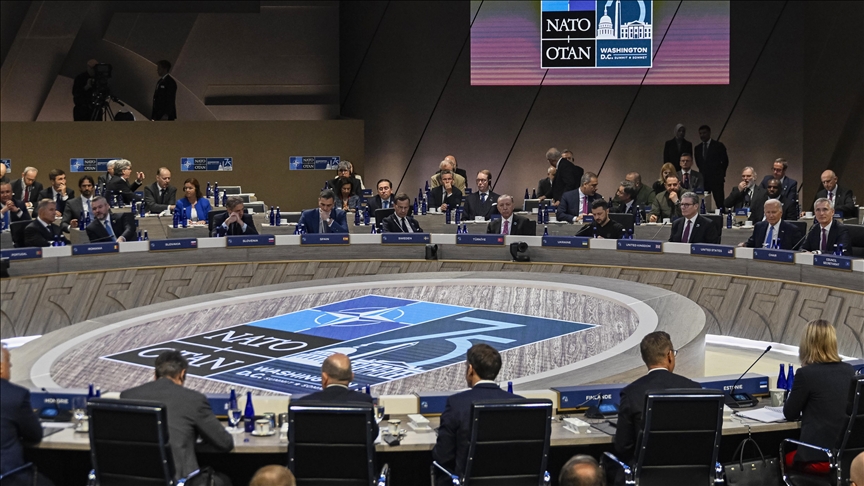 NATO
NATO
- NATO Secretary General Mark Rutte is expected to propose a compromise: a higher spending target coupled with expanded definitions of what counts as defense spending
BRUSSELS
As NATO’s annual summit approaches later this month, allied defense chiefs are set to meet in Brussels Thursday for talks on key agenda items, with a proposed overhaul of defense spending targets in focus.
Set to begin on June 24 in the Netherlands, the two-day summit will bring together heads of state against a backdrop of revived tensions between the US and its European allies.
Since his first term in office, President Donald Trump has demanded some European nations hike their security budgets to meet NATO’s minimum defense spending target of 2% of gross domestic product.
He maintained that tone in a meeting with NATO’s top official, Secretary General Mark Rutte, in March, when he said the US “won’t protect if you’re not paying,” casting doubt on whether Washington would fulfill a key commitment to come to the aid of “delinquent” allies that do not pay enough on their security.
His administration raised the stakes further in February, when Secretary of Defense Pete Hegseth told NATO defense chiefs that Washington expects allies to move far beyond the current 2% target to a minimum of 5% of GDP.
Europe playing catch-up
Hegseth argued that the current imbalance has left America disproportionately funding the alliance's security umbrella. But critics, including in some European capitals, have called the new target unrealistic, as many allies still struggle to meet the 2% threshold, let alone a drastically higher one.
As of 2024, only a handful of NATO members such as Poland, the UK, and the Baltic states fulfill or surpass 2%.
Many European allies, particularly Germany and southern European states, face structural and political barriers to raising defense expenditures. The European average currently hovers at around 1.9%, reflecting decades of underinvestment following the end of the Cold War and a strategic reliance on the US military.
At the same time, the EU has also moved to strengthen its own defense architecture with increased urgency triggered by Russia's invasion of Ukraine, the Trump administration’s unpredictability, and global power shifts.
The bloc has said it wants to boost its defense capabilities and reduce dependency on external suppliers, while complementing US military engagement. It has rolled out a series of initiatives and, earlier this year, the European Commission presented its Defense Industrial Strategy, a first-ever white paper on defense for the bloc.
At the core of this effort is the Strategic Technologies for Europe Platform (STEP), which includes a special fund, known as SAFE, or the Strategic Autonomy Fund for Europe. It aims to ramp up joint procurement, streamline production lines across member states, and support the European defense industry to compete globally. Further goals include accelerating readiness in critical domains such as ammunition, drones, cybersecurity, and AI.
Despite these moves, funding remains limited and coordination among member states is still fragmented, highlighting the difficulty of building strategic autonomy while staying interoperable with NATO.
Possible middle-ground proposal
Secretary General Mark Rutte has spent months navigating a delicate diplomatic environment to craft a compromise between escalating US demands and European realities.
Leveraging his strong ties with former European counterparts, the former Dutch premier has voiced agreement with Washington that the current 2% goalpost is outdated and no longer aligns with modern security threats.
In private and public statements, he has floated a new goal above 3%, but suggested that member states should have more flexibility to reach the target.
Addressing NATO parliamentarians in late May in Dayton, Ohio, he referenced the 5% figure for the first time. This has been taken as a sign that a new collective goal to be unveiled at the upcoming summit may lie somewhere between US demands and European realities.
While stopping short of detailing what the new target might include, Rutte hinted that it might be more diversified than the current model.
Hard spending on weaponry may be complemented by support for cyber defense, infrastructure readiness, and industrial mobilization. Crucially, some reports indicate that NATO members would be able to count additional military aid to Ukraine as defense-related spending, bringing them closer to meeting the alliance’s minimum target.
The proposal appears to aim for a middle ground, offering a way to redefine what counts toward the defense budget, while raising the overall spending level itself.
At present, NATO calculations include traditional categories such as equipment procurement, troop salaries, military infrastructure, and overseas operations. However, they exclude broader security investments like aid to Ukraine, protection of critical infrastructure, or the repurposing of civilian structures like roads and bridges for military use.
Experts suggest that modifying these criteria while setting a new target could help make Washington’s demands more acceptable to European allies.
The new formula is expected to be the centerpiece of Thursday’s meeting in Brussels, where defense ministers will hold their final round of talks before the summit.
Allies will seek agreement on the outline of a new defense investment strategy — one that maintains US presence in Europe while making goals more attainable for European partners.
While the final numbers are still under negotiation, the direction is clear: NATO is preparing to redefine what collective defense means in the current threat environment, rethinking both the scale and scope of defense spending.
Anadolu Agency website contains only a portion of the news stories offered to subscribers in the AA News Broadcasting System (HAS), and in summarized form. Please contact us for subscription options.







